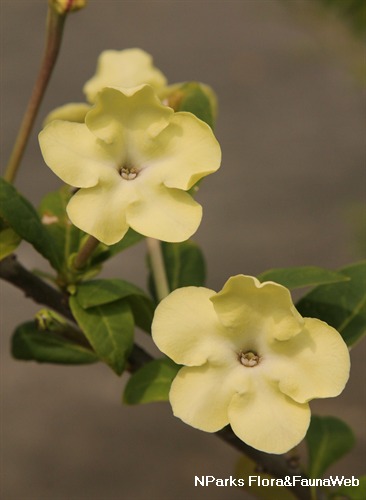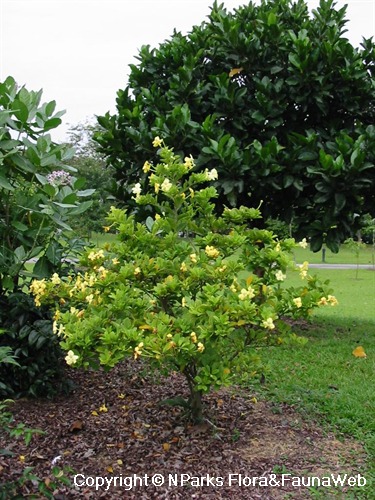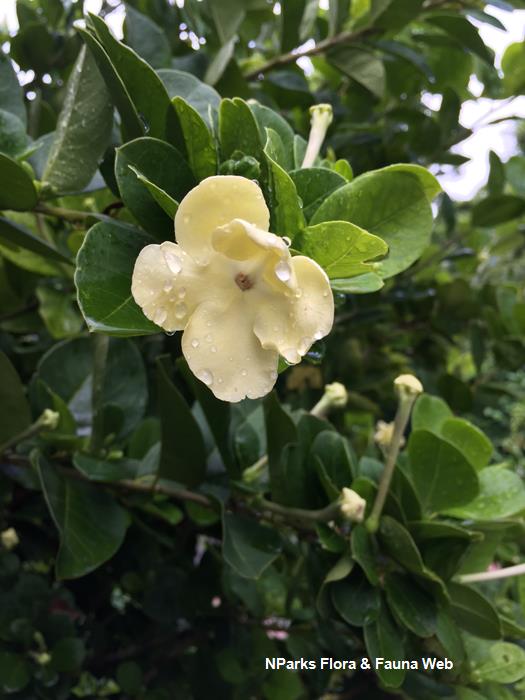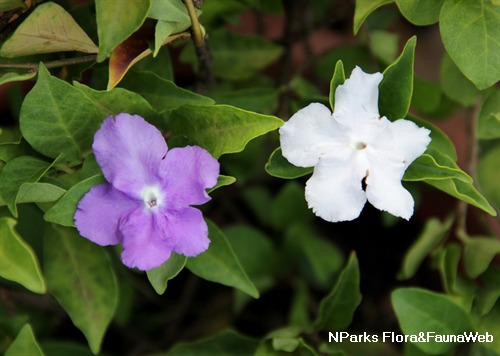
Back
Brunfelsia pauciflora (Cham. & Schltdl.) Benth.
| Family Name: | Solanaceae |
| Synonyms: | Brunfelsia calycina (Cham. & Schltdl.) Benth. |
| Common Name: | Yesterday Today and Tomorrow, Morning Noon & Night, Kiss Me Quick, 大花鸳鸯茉莉, 番茉莉, 变色茉莉 |
Brunfelsia pauciflora also known as Yesterday Today and Tomorrow is a free-flowering perennial shrub, usually cultivated to about 1.5 m tall, but can grow up to 3 m. Under full sun, it can produce abundance of fragrant purple flowers that gradually turns blue or mauve and finally white with aging.
Name
Classifications and Characteristics
| Plant Division | Angiosperms (Flowering Seed Plants) (Dicotyledon) |
|---|---|
| Plant Growth Form | Shrub |
| Lifespan (in Singapore) | Perennial |
| Mode of Nutrition | Autotrophic |
| Plant Shape | Open, Shrubby |
| Maximum Height | 0.6 m to 3 m |
| Maximum Plant Spread / Crown Width | 1 m to 2 m |
Biogeography
| Native Distribution | Brazil |
|---|---|
| Native Habitat | Terrestrial (Disturbed Area / Open Ground) |
| Preferred Climate Zone | Tropical |
| Local Conservation Status | Non-native (Horticultural / Cultivated Only) |
Description and Ethnobotany
| Growth Form | Perennial shrub, up to 3 m tall and spread 2 m wide, but usually 1.5 m tall and 1 m wide. |
|---|---|
| Foliage | Dense and green foliage, semi-deciduous in seasonal countries but evergreen in Singapore. |
| Flowers | Free flowering, blooms in purple, gradually turns blue or mauve and finally white with aging. Bisexual flowers, 5 - petaled, overlapping, white center. |
| Fruit | Fruits are berries, brown when mature, contains many seeds. |
| Cultivation | In Singapore, this plant does not grow well in semi-shade, because it flowers less and is more prone to attack by pests. |
| Etymology | Genus name Brunfelsia is derived from 16th century German monk, Otto Brunfels, who was referred to as the ‘Father of Botany’ because of his significant research contribution to botany. Species pauciflora means few-flowered. |
Landscaping Features
| Desirable Plant Features | Ornamental Flowers, Fragrant (Flowers) (Day) |
|---|---|
| Landscape Uses | General, Flowerbed / Border, Container Planting |
| Thematic Landscaping | Fragrant / Aromatherapy Garden, Butterfly Garden, Wildflower Garden |
| Usage Hazard - Cons | Weak Branches, Toxic Upon Ingestion |
| Usage Hazard - Cons Remarks | Leaves, flowers, berries and seeds are toxic. Consumption of berries by dogs led to convulsions and excess salivaring. |
| Plant & Rootzone Preference or Tolerance Remarks | Compost rich soil. |
Fauna, Pollination and Dispersal
| Fauna Pollination Dispersal Associated Fauna | Butterfly-Attracting |
|---|---|
| Seed or Spore Dispersal | Abiotic (Explosive Dehiscence) |
Plant Care and Propagation
| Light Preference | Full Sun |
|---|---|
| Water Preference | Moderate Water |
| Plant Growth Rate | Slow |
| Rootzone Tolerance | Well-Drained Soils, Acidic (low pH) Soils |
| Maintenance Requirements | Low |
| Pruning | Prune tips after flowering. |
| Fertilizing | Apply fertilizer during flowering. |
| Propagation Method | Seed, Stem Cutting |
| Planting Distance | 1 to 1 |
Foliar
| Foliage Retention | Evergreen |
|---|---|
| Mature Foliage Colour(s) | Green |
| Foliar Type | Simple / Unifoliate |
| Foliar Arrangement Along Stem | Alternate |
| Foliar Shape(s) | Non-Palm Foliage (Ovate) |
| Foliar Venation | Pinnate / Net |
| Foliar Margin | Entire - Wavy / Undulate |
| Typical Foliar Area | Microphyll ( 2.25cm2 - 20.25 cm2 ) |
| Leaf Area Index (LAI) for Green Plot Ratio | 4.5 (Shrub & Groundcover - Dicot) |
Non - Foliar and Storage
| Stem Type & Modification | Woody |
|---|
Floral (Angiosperm)
| Flower & Plant Sexuality | Bisexual Flowers |
| Flower Colour(s) | Purple, White, Blue |
|---|---|
| Flower Texture(s) | Smooth |
| Flower Grouping | Cluster / Inflorescence |
| Flower Location | Terminal |
| Flower Symmetry | Radial |
| Individual Flower Shape | Tubular |
| Inflorescence Type | Cyme |
| Flower Transitional Changes | Colour |
| Flowering Period | Free-Flowering |
| Flowering Opening Time | Daytime |
| Flower Lifespan on Plant | Several Days |
| Flowering Habit | Polycarpic |
| Inflorescence Size Remarks | Blooms are purple, then changes to blue or mauve and finally white. |
Fruit, Seed and Spore
| Mature Fruit Colour(s) | Brown |
|---|---|
| Fruit Type | Dehiscent Dry Fruit , Capsule |
Image Repository
Others
| Master ID | 437 |
|---|---|
| Species ID | 1733 |
| Flora Disclaimer | The information in this website has been compiled from reliable sources, such as reference works on medicinal plants. It is not a substitute for medical advice or treatment and NParks does not purport to provide any medical advice. Readers should always consult his/her physician before using or consuming a plant for medicinal purposes. |

.jpg)
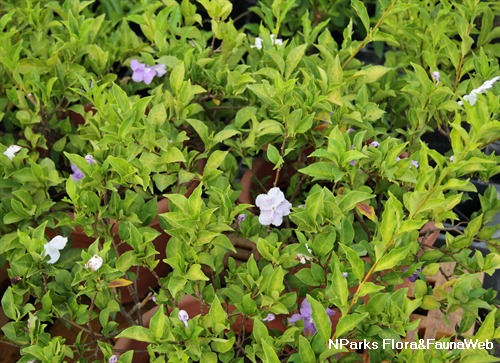
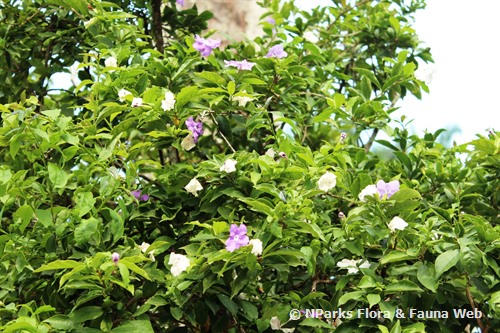
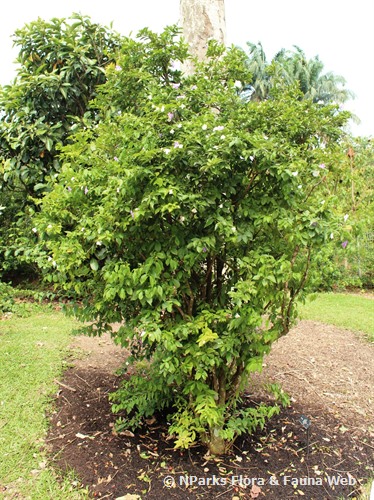

.jpg)
